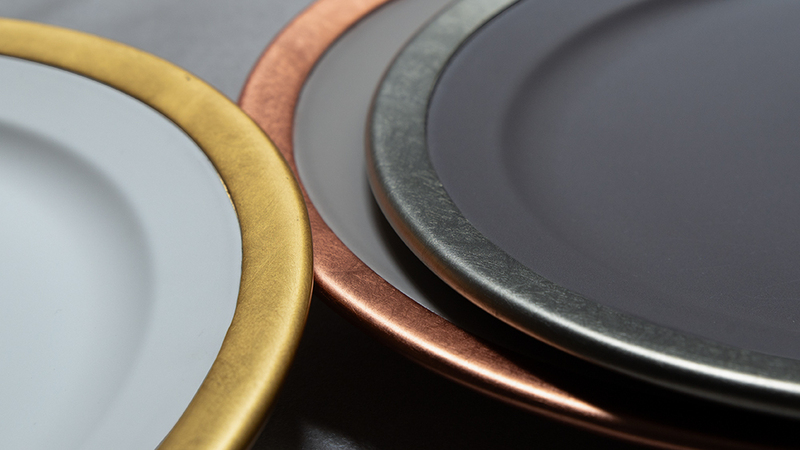NIKKO COMPANY, a Japanese tableware manufacturer established in 1908, has launched “Material Waves™,” a project to discover new values created by crossing NIKKO FINE BONE CHINA with different materials, as it explores new things for the next 100 years.
Two series of tableware, “RINKOU” and “SUZUHAKU” will be released as the first and second products of the project. Both series are products that have been completed through a process of trial and error, making full use of the technology that has been cultivated up to now.
NIKKO has been involved in ceramics for over 100 years and has encountered a wide variety of people and materials. In the “Material Waves™” project launched this year, NIKKO has taken on the challenge of collaborating with bamboo crafts by Chifuyu Enomoto, a bamboo craft artist, and tin by NOUSAKU CORPORATION, a cast metal manufacturer in Takaoka City, Toyama Prefecture.
This project started with the idea that “by sharing techniques and knowledge among people who have faced different materials, we can create products and new values that have never existed before.” By crossing different materials to create new products and continuously disseminating them, we aim to transcend the boundaries between crafts and industrial products, and to preserve the handiwork and traditions of industries and craftspeople throughout Japan.

All materials have wave properties, and the waves that express these properties are called “material wave”. The name of the project is derived from the hope that the waves generated by NIKKO will be transmitted one after another and eventually bring about changes in various forms, while expressing the new possibilities created by the combination of the waves of each material, such as ceramics, bamboo, metal, glass, wood, and so on.
Product Details
・RINKOU Material / Bamboo and NIKKO FINE BONE CHINA
Movie https://www.youtube.com/watch?v=XLaswdScjhU
・SUZUHAKU Material / Tin (three colors by gold foil, copper foil and tin foil)
Movie https://www.youtube.com/watch?v=qiDnV1vqqp4
Dedicated page (Japanese) https://www.nikko-tabletop.jp/pages/material-waves
1st product <NIKKO FINE BONE CHINA × Bamboo > RINKOU

The first series of Material Waves is the “RINKOU” series, a collaboration between NIKKO FINE BONE CHINA and the bamboo crafts of Chifuyu Enomoto, a bamboo craft artist. The series is inspired by the contrast of light and shadow overflowing from the delicate and beautiful mesh drawn by “Rinko weaving”, one of the techniques of bamboo craft, and the transparency of NIKKO FINE BONE CHINA, which shines in white.
The bamboo used for “RINKOU” is madake bamboo from Fukuoka, Japan. Bamboo is supple, tough, lightweight, and strong. It is also water-resistant, so if it gets dirty, wash it in cold water and let it dry, and it will stand up to many years of use.
Chifuyu Enomoto made numerous prototypes in increments of 0.1 mm to achieve a width and thickness of bamboo that is practical to use while maintaining delicacy. Bamboo is a labor-intensive material that varies in softness, hardness, and bendability from one piece to the next. Using about four basic types of tools, the artist’s technique is used to process and finish the product. According to Chifuyu Enomoto, “It is the most primitive of all crafts, and it is precisely because it is a simple job that the skill of the person who made it comes into play.” He says, “It is the most primitive and simple of all crafts.

Prototypes were created repeatedly until completion.
At NIKKO, Wataru Sakuma of the Design Office was in charge of the development. The fine texture of NIKKO FINE BONE CHINA and the rustic texture of bamboo look very different depending on the weaving method and bamboo width, so the delicate balance between the two is very important when developing the product.
One of the characteristics of NIKKO FINE BONE CHINA is its thinness. When weaving bamboo, the thinner the edge, the more beautiful the joint surface. The first challenge required to achieve this is to make the edges of NIKKO FINE BONE CHINA’s raw materials as thin as possible, one by one, by hand. Through repeated trial and error, an unprecedented thinness was achieved.
NIKKO FINE BONE CHINA and bamboo are now firmly interlocked, resulting in a product that is both beautiful and strong.
 Chifuyu Enomoto
Chifuyu Enomoto
Born in Kanagawa Prefecture in 1950. After graduating from university, he studied bamboo craft in Beppu City, Oita Prefecture. In the course of his studies, he decided that he wanted to create lacquer-coated works on bamboo, and studied lacquer craft in Wajima, Ishikawa Prefecture. There was no precedent for using lacquer on bamboo, so he taught himself to create works combining bamboo and lacquer techniques. Among the dozens of different bamboo weaving techniques, he is most skilled at asanoha-ami, one of the basic types of weaving. He has given demonstrations and lectures on bamboo crafts at the Japan Society in New York and studied willow crafts in Germany as an overseas trainee with the Agency for Cultural Affairs.
Lecturer at the Wajima Lacquer Craft Training Institute in Ishikawa Prefecture.
2nd product <NIKKO FINE BONE CHINA × Tin > SUZUHAKU

The second series of Material Waves is “SUZUHAKU,” a collaboration between NIKKO FINE BONE CHINA and tin made by NOUSAKU CORPORATION, a cast metal manufacturer in Takaoka City, Toyama Prefecture, Japan.
The name “SUZUHAKU” is a combination of the characteristic whiteness of NIKKO FINE BONE CHINA, the Japanese sound “haku” meaning “foil” used for the edge finish, and the Japanese sound “suzu” meaning “tin”.
Generally, the most common damage to plates is chipping of the edges. SUZUHAKU was born out of the desire to cover the edge with metal (tin) to make it stronger and to ensure that it can be used with care for many years to come. By establishing a new technique of combining ceramics and metal (tin), we aim to expand the range and possibilities of products that have never been seen before.
Tin is the second most expensive metal after gold and silver. It has antibacterial properties, such as not corroding water and being believed to mellow the flavor of sake, and has long been used as a material for tea and sake vessels.
The tin on the rim of SUZUHAKU is coated with gold, copper, and tin foil. This foil processing is handled by “HAKUICHI”, a company headquartered in Kanazawa City, Ishikawa Prefecture. The edge of the tin material, which is very soft despite being a metal, may be deformed by impact, but such changes over time can be enjoyed for many years as part of the charm of tinware.
The collaborator in the development of SUZUHAKU was NOUSAKU, a Japanese foundry founded in 1916 in Takaoka City, Toyama Prefecture. NOUSAKU went through repeated trial and error to determine how to combine NIKKO FINE BONE CHINA and pure tin, and how to adjust the shape and tin ratio. In particular, we made numerous prototypes to determine how to handle the burrs* that form when the tin is removed from the mold, and how to finish the border between the tin and the tableware cleanly, as well as the surface treatment. After about three years from the conception, we finally arrived at the method of pasting the tin together after casting, and were able to achieve a beautiful finish.
*Burr is a protrusion or spike that occurs when a material is processed.
 Prototypes were created repeatedly until completion.
Prototypes were created repeatedly until completion.
At first, NIKKO wanted to use the “IGURUMI*” method, but after repeated trial runs, it became clear that it would be difficult to produce large-sized tableware. In the first place, burrs are always present in the casting process, so it was extremely difficult to eliminate burrs. Nevertheless, we tried various methods in pursuit of a beautiful finish, and finally arrived at the “pasting together” method.
* IGURUMI: A method in which the material to be integrated is placed in a mold in advance, and melted metal is poured into the mold to integrate the material.
Wataru Sakuma of the NIKKO Design Office, who was in charge of the development, said, “Ceramics, which are pottery, are not all exactly the same. It was difficult to create an even and beautiful finish, taking into account the slight differences between the individual pieces”. He says.
Tin rims attached by “pasting together” are made by a method called “Namagata casting method“. The casting method is traditionally used in Takaoka City, Toyama Prefecture, where casting sand mixed with silica sand and a small amount of water and clay is pressed around a wooden mold to make a sand mold.
Since the molds are not fired or treated with chemicals, the sand can be easily reused and is excellent for mass production. During the prototype production stage of SUZUHAKU, we tried various casting methods, but ultimately decided to adopt this “Namagata casting method“, which can be adapted well to the individual differences of ceramics.

NOUSAKU CORPORATION
Founded in 1916 in Takaoka, Toyama Prefecture, the company began manufacturing castings for Buddhist altar utensils, tea ceremony utensils, flower vases, etc. In 2003, using the craftsmanship inherited from its founding, the company developed the world’s first tableware made of pure tin. Representative works are “Bell” made of brass and “KAGO” made of pure tin.
In addition, the headquarters factory won the grand prize of the Japan Interior Designers Association’s “JID AWARD 2018”.
NIKKO FINE BONE CHINA
NIKKO’s white dinnerware brings out the utmost beauty of any type of food presentation. With our exceptional technology, our Fine Bone China features a unique whiteness, which utilizes about 50% bone ash to create a strong and luminous dinnerware. In order to maintain its clarity, this pottery has a translucent finish. NIKKO FINE BONE CHINA is highly valued by professionals for its beautifulness whiteness and durability.
NIKKO COMPANY

NIKKO was founded in 1908 in Kanazawa, Japan. Already famous for our ironstone ceramics, our commitment to innovation has advanced greatly since the 1970’s. Western materials such as Fine Bone China were introduced and developed using NIKKO’s own advanced technologies. Today, all aspects of production from glaze formulation to mould making are manufactured in-house by our skilled team of craftspeople. The resulting pieces are the some of the finest quality ceramics in the world. In addition, at NIKKO is taking many steps in line with the principals of a circular economy under the theme “Designing a sustainable future for the next 100 years”.
NIKKO COMPANY / Head Office and Factory / 383 Ainoki-machi, Hakusan, Ishikawa, 924-8686, Japan
・Official website / English
https://www.nikko-company.co.jp/en/
・Contact Form
https://sgfm.jp/f/NikkoTabletopEn?_gl=1%2ad4zhzj%2a_gcl_au%2aMTQ5NTM4MDE4NC4xNzExNTg4NTkw
NIKKO COMPANY
・Contact Form
https://sgfm.jp/f/NikkoTabletopEn?_gl=1%2ad4zhzj%2a_gcl_au%2aMTQ5NTM4MDE4NC4xNzExNTg4NTkw




